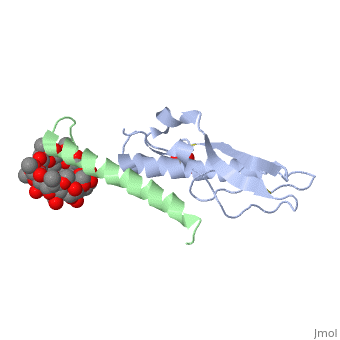Glucose-dependent Insulinotropic Polypeptide Receptor: Difference between revisions
David Canner (talk | contribs) No edit summary |
David Canner (talk | contribs) No edit summary |
||
| Line 1: | Line 1: | ||
<Structure load='2qkh' size='350' frame='true' align='right' caption='Glucose-dependant insulinotropic polypeptide receptor complex with hormone GIP and tartaric acid , [[2qkh]]' scene='' /> | <Structure load='2qkh' size='350' frame='true' align='right' caption='Glucose-dependant insulinotropic polypeptide receptor complex with hormone GIP and tartaric acid , [[2qkh]]' scene='' /> | ||
[[Image:F3.large.jpg|thumb|300px|left|GIP-induced Pathway.<ref>PMID:12475913</ref>]]'''Glucose-dependent insulinotropic polypeptide receptor''' (GIPR) is a transmembrane protein which is responsible for boosting glucose-induced insulin production. The transcription of this protein is positively controlled by glucose molecules; GIPR is expressed in higher levels when glucose is in higher concentration. The receptor is a multispan membrane-bound protein (shown in blue) consisting of an alpha helix, half twist helices, and beta sheets bound in several locations with disulfide bonds within itself. The ligand which binds to GIPR is glucose-dependent insulinotropic polypeptide (GIP), also known as gastric inhibitory polypeptide (shown in green). GIP is an alpha helical endogenous polypeptide hormone which is released upon the ingestion of food, specifically the carbohydrate glucose.<br/> | [[Image:F3.large.jpg|thumb|300px|left|GIP-induced Pathway.<ref>PMID:12475913</ref>]]'''Glucose-dependent insulinotropic polypeptide receptor''' (GIPR) is a transmembrane protein which is responsible for boosting glucose-induced insulin production. The transcription of this protein is positively controlled by glucose molecules; GIPR is expressed in higher levels when glucose is in higher concentration. The receptor is a multispan membrane-bound protein (shown in blue) consisting of an alpha helix, half twist helices, and beta sheets bound in several locations with disulfide bonds within itself. The ligand which binds to GIPR is glucose-dependent insulinotropic polypeptide (GIP), also known as gastric inhibitory polypeptide (shown in green). GIP is an alpha helical endogenous polypeptide hormone which is released upon the ingestion of food, specifically the carbohydrate glucose.<br/> | ||
<br/> | |||
===Molecular Function=== | ===Molecular Function=== | ||
Revision as of 06:41, 23 October 2012
|

Glucose-dependent insulinotropic polypeptide receptor (GIPR) is a transmembrane protein which is responsible for boosting glucose-induced insulin production. The transcription of this protein is positively controlled by glucose molecules; GIPR is expressed in higher levels when glucose is in higher concentration. The receptor is a multispan membrane-bound protein (shown in blue) consisting of an alpha helix, half twist helices, and beta sheets bound in several locations with disulfide bonds within itself. The ligand which binds to GIPR is glucose-dependent insulinotropic polypeptide (GIP), also known as gastric inhibitory polypeptide (shown in green). GIP is an alpha helical endogenous polypeptide hormone which is released upon the ingestion of food, specifically the carbohydrate glucose.
Molecular FunctionMolecular Function
The purpose of the receptor is to bind glucose-dependent insulinotropic polypeptide (GIP) in the presence of glucose. This causes a chain reaction that increases secretion of insulin molecules. GIP binds to GIPR though and causes action of G protein-coupled receptors, which in turn causes an enzymatic cascade resulting in the increased secretion of insulin[2]. This occurs in the pancreatic islet beta-cells. It is likely that the cause of type 2 diabetes is due to the inability of GIP to bind properly to GIPR.
Ongoing ResearchOngoing Research
The significance of this receptor makes it a prime target for diabetes research. Incretins are a class of biological molecules that act like gastrointestinal hormones. One such example is glucagon-like peptide-1 (GLP-1), which works with GIP to regulate the body's insulin levels. Synthetic versions of this peptide hormone have been made to treat people with type-2 diabetes. It works by stimulating GIP production as well as insulin secretion causing the body to properly regulate its blood glucose levels like someone without diabetes. The benefit of synthetic GLP-1 is that it is not protein and so would not be degraded as easily therefore prolonging the benefits of the drug. One such example is Byetta[3].
3D structures of GIPR3D structures of GIPR
2qkh - GIPR + GIP - human
ReferencesReferences
- ↑ Lynn FC, Thompson SA, Pospisilik JA, Ehses JA, Hinke SA, Pamir N, McIntosh CH, Pederson RA. A novel pathway for regulation of glucose-dependent insulinotropic polypeptide (GIP) receptor expression in beta cells. FASEB J. 2003 Jan;17(1):91-3. Epub 2002 Nov 15. PMID:12475913 doi:10.1096/fj.02-0243fje
- ↑ Lynn FC, Pamir N, Ng EH, McIntosh CH, Kieffer TJ, Pederson RA. Defective glucose-dependent insulinotropic polypeptide receptor expression in diabetic fatty Zucker rats. Diabetes. 2001 May;50(5):1004-11. PMID:11334402
- ↑ "Byetta." BYETTA (exenatide) Injection | Welcome to BYETTA.com. Amylin Pharmaceuticals, Inc., 2011. Web. 02 Dec. 2011. <http://www.byetta.com/Pages/index.aspx>
